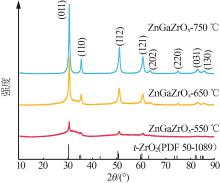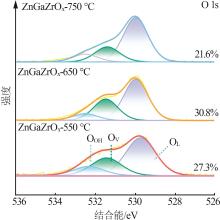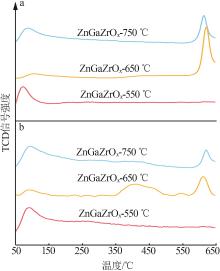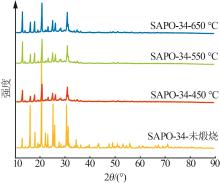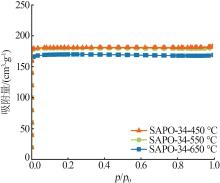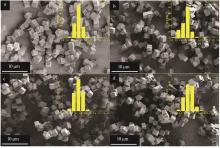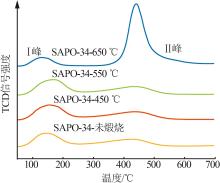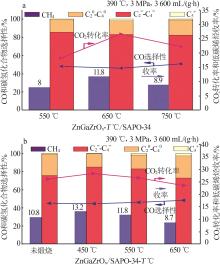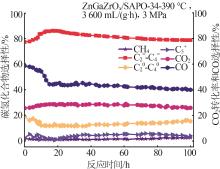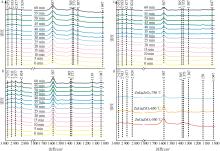Inorganic Chemicals Industry ›› 2024, Vol. 56 ›› Issue (2): 136-145.doi: 10.19964/j.issn.1006-4990.2023-0233
• Catalytic Materials • Previous Articles Next Articles
Effect of calcination temperature on catalytic performance of ZnGaZrO x /SAPO-34
YANG Kun1,2,3( ), REN Qixia1,2,3, DONG Yonggang1,2,3, LIU Fei1,2,3(
), REN Qixia1,2,3, DONG Yonggang1,2,3, LIU Fei1,2,3( ), YAO Mengqin1,2,3, CAO Jianxin1,2,3
), YAO Mengqin1,2,3, CAO Jianxin1,2,3
- 1.School of Chemistry and Chemical Engineering,Guizhou University,Guiyang 550025,China
2.Guizhou Key Laboratory for Green Chemical and Clean Energy Technology,Guiyang 550025,China
3.Guizhou Engineering Research Center of Efficient Utilization for Industrial Waste,Guiyang 550025,China
-
Received:2023-04-24Online:2024-02-10Published:2024-02-06 -
Contact:LIU Fei E-mail:kunyang0511@163.com;ce.feiliu@gzu.edu.cn
CLC Number:
Cite this article
YANG Kun, REN Qixia, DONG Yonggang, LIU Fei, YAO Mengqin, CAO Jianxin. Effect of calcination temperature on catalytic performance of ZnGaZrO x /SAPO-34[J]. Inorganic Chemicals Industry, 2024, 56(2): 136-145.
share this article
| 1 | ALI N, BILAL M, NAZIR M S,et al.Thermochemical and electrochemical aspects of carbon dioxide methanation:A sustainable approach to generate fuel via waste to energy theme[J].Science of the Total Environment,2020,712:136482. |
| 2 | CENTI G, IAQUANIELLO G, PERATHONER S.Can we afford to waste carbon dioxide?carbon dioxide as a valuable source of carbon for the production of light olefins[J].ChemSusChem,2011,4(9):1265-1273. |
| 3 | RAHMAN F A, AZIZ M M A, SAIDUR R,et al.Pollution to solution:Capture and sequestration of carbon dioxide(CO2) and its utilization as a renewable energy source for a sustainable future[J].Renewable and Sustainable Energy Reviews,2017,71:112-126. |
| 4 | ZHOU Wenguang, WANG Jinghan, CHEN P,et al.Bio-mitigation of carbon dioxide using microalgal systems:Advances and perspectives[J].Renewable and Sustainable Energy Reviews,2017,76:1163-1175. |
| 5 | GOUD D, GUPTA R, MALIGAL-GANESH R,et al.Review of catalyst design and mechanistic studies for the production of olefins from anthropogenic CO2 [J].ACS Catalysis,2020,10(23):14258-14282. |
| 6 | WANG Dong, XIE Zhenhua, POROSOFF M D,et al.Recent advances in carbon dioxide hydrogenation to produce olefins and aromatics[J].Chem,2021,7(9):2277-2311. |
| 7 | WITOON T, NUMPILAI T, NUEANGNORAJ K,et al.Light olefins synthesis from CO2 hydrogenation over mixed Fe-Co-K supported on micro-mesoporous carbon catalysts[J].International Journal of Hydrogen Energy,2022,47(100):42185-42199. |
| 8 | YANG Haiyan, ZHANG Chen, GAO Peng,et al.A review of the catalytic hydrogenation of carbon dioxide into value-added hydrocarbons[J].Catalysis Science & Technology,2017,7(20):4580-4598. |
| 9 | WANG Qiang, CHEN Yao, LI Zhenhua.Research progress of catalysis for low-carbon olefins synthesis through hydrogenation of CO2 [J].Journal of Nanoscience and Nanotechnology,2019,19(6):3162-3172. |
| 10 | ZHOU You, QI Liang, WEI Yingxu,et al.Methanol-to-olefin induction reaction over SAPO-34[J].Chinese Journal of Catalysis,2016,37(9):1496-1501. |
| 11 | XU Yanan, GAO Zhihong, PENG Li,et al.A highly efficient Cu/ZnO x/ZrO2 catalyst for selective CO2 hydrogenation to metha- nol[J].Journal of Catalysis,2022,414:236-244. |
| 12 | 路香港,翟岩亮,张健,等.CO/CO2加氢制低碳烯烃催化剂研究进展[J].化工科技,2021,29(4):70-74. |
| LU Xianggang, ZHAI Yanliang, ZHANG Jian,et al.Research progress of catalysts for CO/CO2 hydrogenation to light olefins[J].Science & Technology in Chemical Industry,2021,29(4):70-74. | |
| 13 | LU Siyu, YANG Haiyan, ZHOU Zixuan,et al.Effect of In2O3 particle size on CO2 hydrogenation to lower olefins over bifunctional catalysts[J].Chinese Journal of Catalysis,2021,42(11):2038-2048. |
| 14 | DANG Shanshan, GAO Peng, LIU Ziyu,et al.Role of zirconium in direct CO2 hydrogenation to lower olefins on oxide/zeolite bifunctional catalysts[J].Journal of Catalysis,2018,364:382-393. |
| 15 | GAO Peng, DANG Shanshan, LI Shenggang,et al.Direct production of lower olefins from CO2 conversion via bifunctional catalysis[J].ACS Catalysis,2018,8(1):571-578. |
| 16 | ZHANG Peng, MA Lixuan, MENG Fanhui,et al.Boosting CO2 hydrogenation performance for light olefin synthesis over GaZrO x combined with SAPO-34[J].Applied Catalysis B:Environmental,2022,305:121042. |
| 17 | ZHANG Wenyu, WANG Sen, GUO Shujia,et al.Effective conversion of CO2 into light olefins over a bifunctional catalyst consisting of La-modified ZnZrO x oxide and acidic zeolite[J].Catalysis Science & Technology,2022,12(8):2566-2577. |
| 18 | PARK G C, SEO T Y, PARK C H,et al.Effects of calcination temperature on morphology,microstructure,and photocatalytic performance of TiO2 mesocrystals[J].Industrial & Engineering Chemistry Research,2017,56(29):8235-8240. |
| 19 | TAHERI A, BABAKHANI E G, TOWFIGHI J.Study of synthesis parameters of MIL-53(Al) using experimental design methodology for CO2/CH4 separation[J].Adsorption Science & Technology,2018,36(1/2):247-269. |
| 20 | KUWAHARA Y, MIHOGI T, HAMAHARA K,et al.A quasi-stable molybdenum sub-oxide with abundant oxygen vacancies that promotes CO2 hydrogenation to methanol[J].Chemical Science,2021,12(29):9902-9915. |
| 21 | 张鹏,孟凡会,杨贵楠,等.金属氧化物在OX-ZEO催化剂中催化CO x 加氢制低碳烯烃研究进展[J].化工进展,2022,41(8):4159-4172. |
| ZHANG Peng, MENG Fanhui, YANG Guinan,et al.Progress of metal oxide in OX-ZEO catalyst for CO x hydrogenation to light olefins[J].Chemical Industry and Engineering Progress,2022, 41(8):4159-4172. | |
| 22 | HE Hui, LIN Xueting, LI Shujun,et al.The key surface species and oxygen vacancies in MnO x (0.4)-CeO2 toward repeated soot oxidation[J].Applied Catalysis B:Environmental,2018,223:134-142. |
| 23 | WANG Sen, WANG Pengfei, SHI Dezhi,et al.Direct conversion of syngas into light olefins with low CO2 emission[J].ACS Catalysis,2020,10(3):2046-2059. |
| 24 | 范兴其,姚梦琴,刘飞,等.制备方法对Al2O3-CeO2物化性质及CO2加氢制甲醇催化性能的影响[J].人工晶体学报,2021,50(9):1745-1755,1795. |
| FAN Xingqi, YAO Mengqin, LIU Fei,et al.Effect of preparation methods on physicochemical properties of Al2O3-CeO2 and its catalytic performance of CO2 hydrogenation to methanol[J].Journal of Synthetic Crystals,2021,50(9):1745-1755,1795. | |
| 25 | LIN Bingyu, WANG Rong, YU Xiujin,et al.Physicochemical characterization and H2-TPD study of alumina supported ruthenium catalysts[J].Catalysis Letters,2008,124(3):178-184. |
| 26 | MILLER J T, MEYERS B L, MODICA F S,et al.Hydrogen temperature-programmed desorption(H2 TPD) of supported pla-tinum catalysts[J].Journal of Catalysis,1993,143(2):395-408. |
| 27 | WANG Mengheng, WANG Ziwei, LIU Suhan,et al.Synthesis of hierarchical SAPO-34 to improve the catalytic performance of bifunctional catalysts for syngas-to-olefins reactions[J].Journal of Catalysis,2021,394:181-192. |
| 28 | TIAN Pan, ZHAN Guowu, TIAN Jian,et al.Direct CO2 hydrogenation to light olefins over ZnZrO x mixed with hierarchically hollow SAPO-34 with rice husk as green silicon source and templa-te[J].Applied Catalysis B:Environmental,2022,315:121572. |
| 29 | 季超,武鲁明,李滨,等.甲醇制烯烃催化剂SAPO-34分子筛的改性研究进展[J].无机盐工业,2022,54(7):1-9,90. |
| JI Chao, WU Luming, LI Bin,et al.Research progress on modification of SAPO-34 as catalyst for methanol to olefins[J].Inorganic Chemicals Industry,2022,54(7):1-9,90. | |
| 30 | MA Yuanyuan, LI Zhifang, ZHAO Nan,et al.One-pot synthesis of CNT-SAPO-34 composite supported copper and cerium catalysts with excellent surface resistance to SO2 and H2O in NH3-SCR[J].Journal of Rare Earths,2023,41(9):1344-1352. |
| 31 | LIU Xiaoliang, WANG Mengheng, YIN Haoren,et al.Tandem catalysis for hydrogenation of CO and CO2 to lower olefins with bifunctional catalysts composed of spinel oxide and SAPO-34[J].ACS Catalysis,2020,10(15):8303-8314. |
| 32 | HUANG Fangtao, CAO Jianxin, WANG Le,et al.Enhanced catalytic behavior for methanol to lower olefins over SAPO-34 composited with ZrO2 [J].Chemical Engineering Journal,2020,380:122626. |
| 33 | FUJIMOTO Y, SHU Y, MIYAKE K,et al.SAPO-34 zeolite nanocrystals coated with ZrO2 as catalysts for methanol-to-olefin conversion[J].ACS Applied Nano Materials,2021,4(8):8321-8327. |
| 34 | 李雯,詹国武,黄加乐,等.基于金属有机骨架和稻谷壳前体构筑ZnZrO x &bio-SAPO-34双功能催化剂及CO2加氢制低碳烯烃[J].化工进展,2022,41(3):1298-1308. |
| LI Wen, ZHAN Guowu, HUANG Jiale,et al.Synthesis of ZnZrO x & bio-SAPO-34 bifunctional catalysts derived from metal organic frameworks and rice husk template for CO2 hydrogenation to light olefins[J].Chemical Industry and Engineering Progress,2022,41(3):1298-1308. | |
| 35 | 杨浪浪,孟凡会,张鹏,等.ZrCdO x /SAPO-18双功能催化剂催化CO2加氢合成低碳烯烃性能[J].无机化学学报,2021,37(3):448-456. |
| YANG Langlang, MENG Fanhui, ZHANG Peng,et al.Catalytic performance for CO2 hydrogenation to light olefins over ZrCdO x /SAPO-18 bifunctional catalyst[J].Chinese Journal of Inorganic Chemistry,2021,37(3):448-456. | |
| 36 | MENG Fanhui, LI Xiaojing, ZHANG Peng,et al.Highly active ternary oxide ZrCeZnO x combined with SAPO-34 zeolite for direct conversion of syngas into light olefins[J].Catalysis Today,2021,368:118-125. |
| 37 | RHODES M, POKROVSKI K, BELL A.The effects of zirconia morphology on methanol synthesis from CO and H2 over Cu/ZrO2 catalystsPart Ⅱ.Transient-response infrared studies[J].Journal of Catalysis,2005,233(1):210-220. |
| 38 | WANG Yuhao, GAO Wengui, LI Kongzhai,et al.Strong evidence of the role of H2O in affecting methanol selectivity from CO2 hydrogenation over Cu-ZnO-ZrO2 [J].Chem,2020,6(2):419-430. |
| 39 | XU Di, HONG Xinlin, LIU Guoliang.Highly dispersed metal doping to ZnZr oxide catalyst for CO2 hydrogenation to methanol:Insight into hydrogen spillover[J].Journal of Catalysis,2021,393:207-214. |
| 40 | KATTEL S, YAN Binhang, YANG Yixiong,et al.Optimizing binding energies of key intermediates for CO2 hydrogenation to methanol over oxide-supported copper[J].Journal of the American Chemical Society,2016,138(38):12440-12450. |
| 41 | LIU Xiaoliang, ZHOU Wei, YANG Yudan,et al.Design of efficient bifunctional catalysts for direct conversion of syngas into lower olefins via methanol/dimethyl ether intermediates[J].Che- mical Science,2018,9(20):4708-4718. |
| 42 | MALIK A S, ZAMAN S F, AL-ZAHRANI A A,et al.Development of highly selective PdZn/CeO2 and Ca-doped PdZn/CeO2 catalysts for methanol synthesis from CO2 hydrogenation[J].Applied Catalysis A:General,2018,560:42-53. |
| 43 | SONG Jimin, LIU Sihang, YANG Chengsheng,et al.The role of Al doping in Pd/ZnO catalyst for CO2 hydrogenation to metha-nol[J].Applied Catalysis B:Environmental,2020,263:118367. |
| [1] | QIAN Zhihui, ZHU Qin, MA Jiao, GUO Yujiao, XIANG Mingwu, GUO Junming. Study on preparation and electrochemical properties of nano-sized LiNi0.05Mn1.95O4 cathode materials [J]. Inorganic Chemicals Industry, 2024, 56(4): 50-56. |
| [2] | ZHAN Sijin, LIU Shike, LIU Fei, YAO Mengqin, CAO Jianxin. Study on preparation and catalytic performance of ZnO-CeO2 [J]. Inorganic Chemicals Industry, 2024, 56(3): 137-143. |
| [3] | REN Qixia, YANG Kun, LIU Fei, YAO Mengqin, CAO Jianxin. Effect of promoter on physicochemical properties and catalytic performance of ZnO/ZrO2 [J]. Inorganic Chemicals Industry, 2024, 56(3): 144-154. |
| [4] | LI Qiang, YOU Xiaomin, SHE Xuefeng, JIANG Zeyi, XUE Qingguo, WANG Jingsong. Effect of calcination temperature and carbon structure on compressive strength of CaO-containing carbon pellets [J]. Inorganic Chemicals Industry, 2023, 55(9): 43-49. |
| [5] | YANG Tinglong,WANG Fuzhong,LIU Fei. Study on sulfur poisoning of zirconium-based bimetallic oxides catalyst [J]. Inorganic Chemicals Industry, 2023, 55(1): 151-158. |
| [6] | Zhang Li,Sun Zhaolin,Wang Jiujiang,Hu Qingxun,Liu Honghai,Zhao Xiaozheng,Zhao Hongjuan,Xiong Xiaoyun,Song Lijuan,Qin Yucai. Study on performance and mass transfer and diffusion behavior of citric acid modified in situ crystallization catalyst [J]. Inorganic Chemicals Industry, 2021, 53(4): 101-106. |
| [7] | Xiao Yihan,Cao Jianxin,Liu Fei,Yi Yun. Effect of calcination temperature on physicochemical properties and catalytic performance of MnZnOx [J]. Inorganic Chemicals Industry, 2021, 53(4): 95-100. |
| [8] | Li Xiangguo,Guo Miao,Yao Huimin,Lü Jing. Research on hydrothermal synthesis and photoluminescence mechanism of rhombus CeO2 [J]. Inorganic Chemicals Industry, 2020, 52(6): 30-35. |
| [9] | MA Yun, MAO Xiao-Ming, WU Xin, FAN Zhen. Synthesis and characterization of niobium doped mesoporous zirconia composite catalysts [J]. INORGANICCHEMICALSINDUSTRY, 2015, 47(2): 75-. |
| [10] | PENG Gong-Ming, YI De-Lian, WU Lin-1, ZENG Dan-Lin, YAN Xiao-Chao. Study on acid-base properties and structure of nitrogen-incorporated Y and HZSM-5 zeolites [J]. INORGANICCHEMICALSINDUSTRY, 2013, 45(3): 58-. |
| [11] | ZHANG Xiao-Bo, LIU Hong-Guang, YE Xue-Hai, FU Chun-Ming, YU Xiao-Wei, ZHANG Chun-Li, XIAO Cai-Ying, XIA Ji-Ping. Effect of calcination temperature on structure and electrochemical properties of LiMn2O4 [J]. INORGANICCHEMICALSINDUSTRY, 2012, 44(7): 31-. |
| [12] | Liu Jinping;Zhao Hong;Song Xiaoli;Li Xiaolei. Effects of calcination temperature on structure of titanium oxide photocatalyst [J]. INORGANICCHEMICALSINDUSTRY, 2009, 0(9): 0-0. |
| [13] | Liu Dingfu;Huang Lingtao;Wang Dong. Effect of acidity on preparation of cuprous chloride by nantokite reduction method [J]. INORGANICCHEMICALSINDUSTRY, 2008, 0(12): 0-0. |
| Viewed | ||||||
|
Full text |
|
|||||
|
Abstract |
|
|||||
|
||
